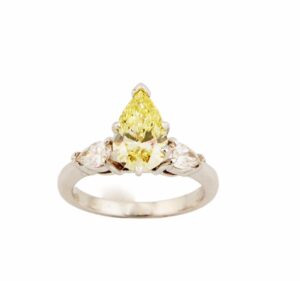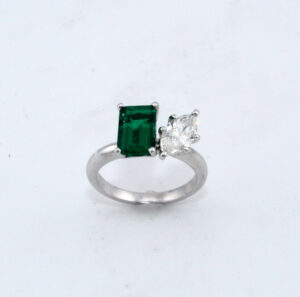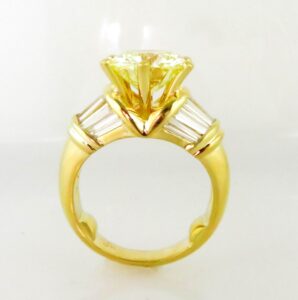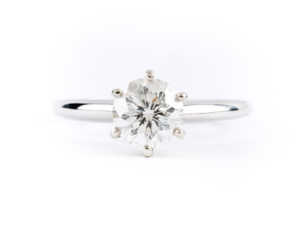Diamonds have long been prized for their brilliance and rarity, but colored diamonds take this allure to another level. While traditional white diamonds are known for their purity, colored diamonds come in an array of stunning hues, from deep blues to radiant pinks. In this guide, we’ll explore the world of colored diamonds, their origins, value, and what makes them truly special.
Understanding Diamond Colors

Colored diamonds develop when there is some element or structural imperfection in their course of formation as natural diamonds. While white diamonds are evaluated against their absence of color, fancy colored diamonds are appreciated for how deep and how rich the colors are.
How Do Diamonds Get Their Color?
Incorporation of specific elements or a modification in atomic composition during diamond formation causes them to be different shades:
- Yellow and Orange Diamonds: Because of a trace of nitrogen.
- Blue Diamonds: Were the result of the existence of boron.
- Pink and Red Diamonds: Were the result of changing the atomic configuration of the diamond due to high pressure.
- Green Diamonds: Were the result of natural radiation exposure.
- Black Diamonds: Have many inclusions of minerals or graphite.
Popular Colored Diamonds

There are some color diamonds that occur more often, but there are a few which are extremely rare and costly. Let’s have a closer view at some of the most precious ones:
Fancy Yellow Diamonds
Some of the most coveted and cheapest colour diamonds are fancy yellow diamonds. Their intense color is due to nitrogen inclusions that cause blue light absorption and thus yellowish hues. The yellowness of the diamond, the greater it will be.
Blue Diamonds
Blue diamonds, including the fabled Hope Diamond, owe their bright color to boron atoms in the crystal lattice. Such rare and precious stones are commanding record prices for saturated blues of rich color.
Pink Diamonds
Pink diamonds are probably the most rare and precious colored diamonds. While all the others obtain their color according to impurities, pink diamonds obtain their color due to a defect in their crystal lattice. Prior to the Argyle Mine in Australia closing down, the major source of pink diamonds, their rarity and value have since gone stratospheric.
Green Diamonds
These diamonds acquire their green color due to natural radiation over millions of years. Pure green diamonds that are equally saturated are not very common, however.
Red Diamonds
The rarest of all the fancy-colored diamonds are the red diamonds. They acquire their deep red color due to exceptional atomic distortions. One of the most well-known ones is the Moussaieff Red Diamond, a 5.11-carat red diamond.
Black Diamonds
Sometimes referred to as carbonado diamonds, black diamonds have high levels of graphite within them, which makes them dark, heavy, and impenetrable. Black diamonds are not typically cut to the standard shape as other fancy-colored diamonds.
Factors That Affect Colored Diamond Value

Unlike white diamonds, colored diamonds are graded according to a range of factors. The most important factors towards their value are:
- Color Intensity: The most important feature is the color intensity. The deeper and darker the color, the costlier the diamond.
- Carat Weight: Deep and heavy colored diamonds are highly rare and costly.
- Cut: Diamond cut might affect the performance of light as far as color is concerned.
- Clarity: For colored diamonds, as with white diamonds, clarity is not exactly a matter because inclusions are not necessarily apparent.
History’s Colored Diamonds
Some colored diamonds in history have attained a legendary status.
- The Hope Diamond (Blue): A blue diamond weighing 45.52 carats that’s famous for its chequered past and bad luck legend.
- The Pink Star Diamond (Pink): A 59.60-carat flawless pink diamond that shattered auction records.
- The Dresden Green Diamond (Green): It is the largest and most renowned green diamond weighing 41 carats.
Investing in Colored Diamonds
With their rarity and increasing demand, colored diamond necklaces make an attractive investment. Here are some key tips for potential investors:
- Research the Market: Colored diamonds fluctuate in value, so staying informed about market trends is crucial.
- Buy Certified Diamonds: Always ensure your diamond is GIA-certified to confirm its authenticity and grading.
- Consider Rarity Over Size: A smaller diamond with intense color is often more valuable than a larger diamond with a faint hue.
Caring for Colored Diamonds
To maintain their beauty and brilliance, colored diamonds require proper care:
- Cleaning: Use a soft brush and mild soapy water to clean your diamond regularly.
- Storage: Store them separately from other jewelry to prevent scratches.
- Professional Maintenance: Have them inspected by a professional jeweler periodically.
Conclusion
Colored diamonds are nature’s masterpieces, offering a unique and captivating alternative to traditional white diamonds. Whether you’re considering one for investment, an engagement diamond ring, or simply for its beauty, understanding their rarity and characteristics will help you make an informed choice. With proper care, a colored diamond can be a breathtaking piece to cherish for generations to come. Visit Gem Boutique to explore a stunning collection of exquisite colored diamonds and find the perfect piece for your collection.
Diamonds have been looked at for several centuries as a symbol of beauty, rarity, and value. Evolution of diamonds: Precious more than stones From their genesis inside the core of the Earth and their uses in modern society including ornaments. There exists a story of history, love, and timeless elegance associated with a waltz.
The Fascinating History of Diamonds
Diamonds have a history dating over 2,000 years, since they were discovered in ancient India. In those days, the brilliance of stones was very high, and they were thought to possess magic that would keep evil at bay. Diamonds used to be worn by people as they were found because they looked like talismans or had divine power inside them.
In the Middle Ages, when diamonds traveled along trade routes to Europe, they were considered the ultimate symbol of wealth and prestige. They were used by kings and nobles to decorate their crowns and ceremonial jewelry, representing power and prosperity.
Diamonds in Jewelry Through the Ages
Diamonds became a norm in jewelry during the Renaissance. With the invention of diamond cutting, jewelers could enhance a diamond’s natural brilliance, thus making it a centerpiece for luxurious adornments.
It began with the use of diamonds in jewelry in the late 15th century by Archduke Maximilian of Austria giving the first recorded diamond engagement ring to Mary of Burgundy, and the action set in a trend for eternity that made diamond rings a global icon of love and commitment.
It was in the Victorian era when diamonds were often paired with other gemstones in intricate designs, reflecting a romantic style that continues to inspire modern jewelry.
The Rise of Diamond Jewelry in the Modern Era
The discovery of diamonds in South Africa was a revelation during the 19th century. With abundant diamonds available, they are now within the reach of many. It was during this time that diamond marketing campaigns that related diamonds with emotions and milestones were invented.
The phrase, “A diamond is forever,” coined by De Beers in 1947, set diamonds as the ultimate expression of eternal love. No wonder diamond rings became the most popular engagement ring globally.
Diamond jewelry is not only for engagements today. Necklaces and earrings, bracelets, and even accessories for everyday wear are now made with diamonds, signifying elegance and class.
Why Diamonds Continue to Shine Bright
Diamonds hold deep cultural and personal significance. They are more than beautiful gemstones – they are symbols of lasting memories and cherished moments.
- A Symbol of Love: Diamond rings have become a timeless tradition for engagements and weddings, symbolizing eternal bonds.
- Status and Elegance: Wearing diamond jewelry has long been associated with class, sophistication, and success.
- A Connection to History: Heirloom diamond jewelry pieces carry stories from one generation to the next, making them priceless treasures.
In today’s world, diamonds are also celebrated for their versatility. Whether you choose traditional mined diamonds or modern lab-grown options, they continue to captivate with their unmatched brilliance.
Learn More: Natural Diamonds vs. Lab-Created
Conclusion
The history of diamonds shows their incredible journey from ancient India to modern jewelry collections. Diamonds in jewelry, from elegant necklaces to radiant earrings or iconic diamond rings, really do hold a special place in our hearts and traditions.
At GEM Boutique, we celebrate the timeless beauty and significance of diamond jewelry. We believe that whether you’re seeking a classic piece or something uniquely personal, we’re here to help you find a diamond that tells your story. Come and explore our collection, and discover why diamonds are the ultimate symbol of love and elegance.
All diamonds have been accepted for their beauty, for their rarity, and for their strength. Even if lab-grown diamonds are gaining popularity in the markets lately as an alternative and sustainable approach, many still believe that natural diamonds make for a better choice. Let us cut across the aisles and examine why natural diamonds have a distinctly superior advantage over lab-grown diamonds for various reasons.

Understanding Natural vs. Lab-created Diamonds
Natural diamonds take millions of years to be made deep down in the Earth under terrific heat and pressure. But lab-diamonds are mimicked in a lab relative to such conditions with a much faster production time. They are chemically the same, but they have differences in several key areas, which is why many people still prefer natural diamonds. In fact, learning how natural and lab created diamonds differ explains, to a great extent, why most people still prefer the former.
The Formation Process: Natural vs. Lab-created
How Natural Diamonds Are Formed
Natural diamonds are produced through geological processes, ultimately taking millions of years. Deep inside the Earth’s crust, pressure and heat conditions are extreme to make carbon atoms crystallize into diamonds. Such slow processes make each diamond unique and highly elegant. In sharp contrast, lab diamonds form within a time span that could be as short as weeks or months, while naturally, this takes millions of years.
The Technology Behind Lab-created Diamonds
There are actually two ways that lab diamonds are made: either High Pressure High Temperature (HPHT) or Chemical Vapor Deposition (CVD). These are conditions mimicking natural origins, but only take a few weeks to form a diamond- whereas it can take tens of millions of years for it to be naturally created. That itself makes it expensive and lowers the perceived value in regard to real diamonds.
Rarity and Value
Why Rarity Makes Natural Diamonds Priceless
The natural diamond is valued due to its rarity. Natural diamonds are only produced after millions of years. Their supply is very minimal because the period taken to produce natural diamonds is so long, making it hold more value. Rarity adds to the price of a product, and therefore is the most expensive in the jewelry market. Evidently, the difference falls on when the natural and lab-grown diamonds differ on this aspect. No natural diamond can be replaced by any other.
Are Lab-created Diamonds Less Valuable?
Although the lab-made diamond has the same composition as its natural cousins, they fetch a lower price primarily because they are not scarce. Thus, more pieces can be produced to facilitate the market. Such abundance reduces their value but increases their affordability. Often, they don’t attract as heavy a price as natural diamonds.
Aesthetic Differences
Visual Qualities of Natural Diamonds
This makes natural diamonds unique because nobody is alike. A natural diamond takes millions of years to form. During the process, minute imperfections, known as inclusions, make every diamond characteristic. Sometimes, these inclusions even help make it more brilliant and sparkling for beauty in the eyes of many buyers.
Comparing the Appearance of Lab-created Diamonds
Lab-grown diamonds are often flawless at sight, which may be seen as a drawback since they don’t have the inclusions that make a natural diamond special. They are, however, brilliant and very beautiful. For many buyers, such imperfections in natural diamonds make them unique. This debate takes the issue of lab diamonds vs real diamonds with respect to appearance.
Environmental Impact
The Sustainability Debate: Natural Diamonds
The environmental impact of diamond mining has been a subject of debate for years. While it is true that mining can cause significant environmental damage, many diamond mines now follow strict regulations and employ more sustainable practices to reduce their footprint. Natural diamonds can be responsibly sourced, and efforts to minimize their environmental impact are increasing.
Lab-created Diamonds and Their Environmental Footprint
Lab-created diamonds are often considered more eco-friendly because they don’t require mining. However, the energy required to create diamonds in a lab can be substantial, particularly when the energy used is not sourced from renewable resources. So, while lab-created diamonds may seem like the greener option, their environmental impact largely depends on how they are produced.
Durability and Longevity
How Natural Diamonds Stand the Test of Time
Diamonds are known for their exceptional durability, ranking as the hardest natural material on Earth. Natural diamonds have stood the test of time, enduring for billions of years. Their strength ensures they can withstand everyday wear and remain beautiful for generations.
Are Lab-created Diamonds Less Durable?
Lab-created diamonds share the same hardness and durability as natural diamonds because they have the same chemical composition. They are just as resistant to scratches and damage. However, the long history of natural diamonds, and the idea that they have lasted billions of years, gives them a certain level of timelessness that lab-created diamonds can’t quite match.
Cultural and Emotional Value
The Timeless Symbolism of Natural Diamonds
Natural diamonds carry a deep cultural and emotional significance. They have been used for centuries to symbolize love, commitment, and enduring beauty, especially in engagement rings. The rarity and uniqueness of natural diamonds make them a cherished possession, often passed down through generations. For many, this emotional connection is something that lab-created diamonds struggle to replicate.
Emotional Significance of Lab-created Diamonds
Lab-created diamonds are still beautiful and meaningful, but they may not evoke the same level of emotion or cultural significance as natural diamonds. Some people may feel that because lab-created diamonds are man-made, they lack the deeper connection and symbolic weight that comes with a natural diamond.
Price Considerations
Why Natural Diamonds Are More Expensive
The price of natural diamonds is influenced by factors such as rarity, size, color, and clarity. Since natural diamonds are much rarer than lab-created diamonds, they come with a higher price tag. The process of mining, cutting, and certifying natural diamonds also adds to the overall cost. Many people find that the higher cost of natural diamonds is justified by their unique qualities.
Is the Price Difference Worth It?
Although lab-created diamonds are less expensive, many people are willing to pay the premium for a natural diamond. The higher price reflects the rarity, history, and value of a natural diamond, making it a worthwhile investment for many buyers. For others, the lower price of a lab-created diamond makes it a more practical choice, leading them to ask, which is better: lab or natural diamond?
Investment Potential
The Investment Value of Natural Diamonds
Natural diamonds are often seen as a long-term investment. Their rarity, beauty, and historical value mean that they can appreciate over time. As a result, natural diamonds are considered a stable asset that can hold or even increase in value over the years.
Will Lab-created Diamonds Hold Their Value?
Lab-created diamonds, however, do not have the same investment potential as natural diamonds. Because they are more abundant and less rare, they are unlikely to increase in value over time. For many buyers, the investment value of a natural diamond is a major reason why they choose it over a lab-created one.
Conclusion
While lab-created diamonds are a more affordable and environmentally friendly option, natural diamonds still hold a distinct advantage in several important areas. Their rarity, emotional value, cultural significance, and long-term investment potential make them a timeless choice. Whether for an engagement ring, heirloom piece, or investment, natural diamonds continue to be regarded as the superior option for many buyers. The lab or natural diamond debate ultimately comes down to personal preference, but for many, natural diamonds will always be the better choice.
In the end, both natural and lab-created diamonds have their place in the market. However, for those who value history, rarity, and emotional significance, natural diamonds will always hold a special allure that lab-created diamonds simply can’t match.
At GEM Boutique, we understand and celebrate the unique qualities of both natural and lab-created diamonds, offering a selection to meet the diverse tastes and values of our customers.




